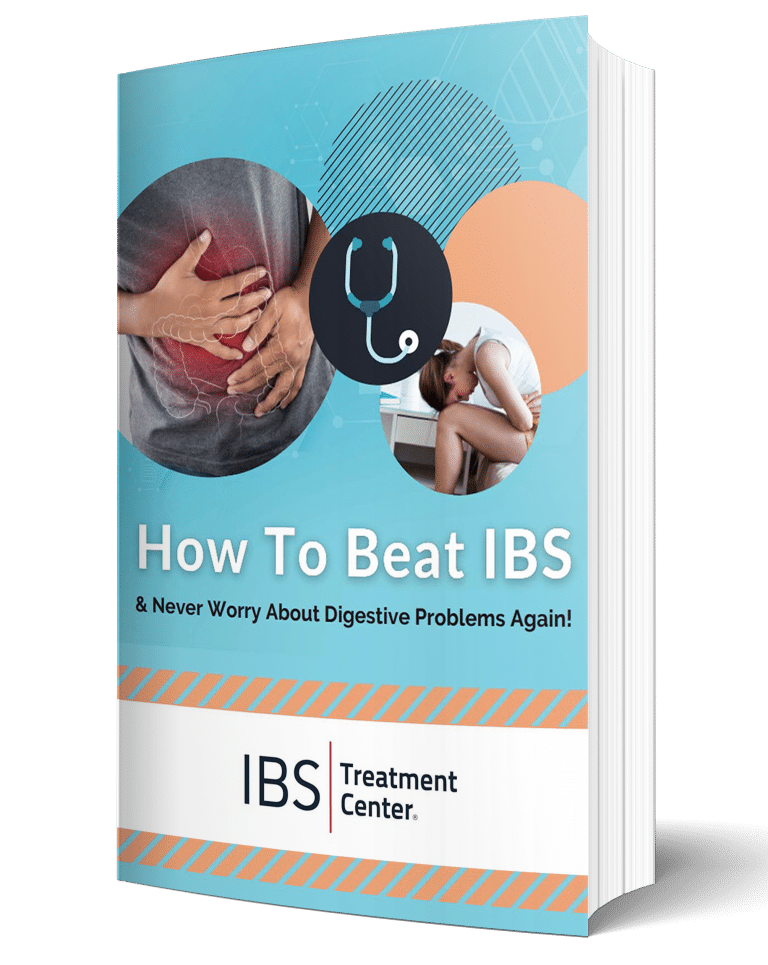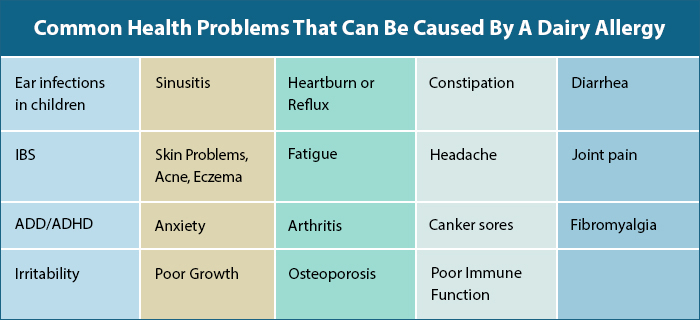HOW IS LACTOSE INTOLERANCE DIFFERENCE THAN A DAIRY ALLERGY?
Lactose intolerance is frequently confused with milk allergy, but the two conditions are not the same. A dairy allergy is an immune response that results in inflammation and tissue damage. Such a response to food can be exhibited in any part of the body, therefore it can cause a wide range of problems.
Lactose intolerance is an enzyme deficiency, not an allergy. Many people are lactose intolerant, but millions more have an immune reaction to dairy. Unfortunately, most people don’t recognize that there is a difference between the two issues.
Lactase Is an Enzyme
First, let’s clear up exactly what lactose intolerance is. Lactose intolerance is a deficiency in the enzyme lactase which leads to an impaired ability to digest lactose, which is milk sugar.
The cells lining the digestive tract produce lactase, however many people don’t produce enough lactase to adequately digest this milk sugar. Therefore, these individuals are intolerant to milk sugar.
Many patients complain of a lactose intolerance because they know that they have a problem with dairy products. They usually think taking a digestive product designed for lactose intolerance will resolve their digestive problems. Sometimes it does, but often it doesn’t. When that is happening it’s because what they are experiencing is really a dairy allergy.
Lactose Intolerance Is a Serious Health Problem
Inability to digest and absorb lactose leads to gas, bloating, diarrhea, and abdominal pain. This can be very problematic, but is also very temporary. It will only last a few hours at most.
Any symptoms that last longer must be due to a dairy allergy. A dairy allergy causes irritation of the lining of the intestines. This irritation in turn leads to a weakened digestive system that exposes you to other potential systemic disorders.
In addition to an inability to absorb needed nutrients, a weakened digestive system is more susceptible to attack by parasites, yeast, and pathogenic bacteria, which worsens the problems in your intestines and also exposes you to chronic disease.
Some people have people a lactose intolerance and a dairy allergy. The inability to digest dairy will be just the tip of the iceberg. They often have other problems that indicate the presence of a dairy allergy.
Lactose Intolerance Is a Common Problem
More than 50 million Americans are lactose intolerant and nearly two-thirds of the world’s adult population has some degree of difficulty with the digestion of milk sugar because of a lactase deficiency:
- 97-100 percent of African Blacks
- 90-100 percent of Asians
- 70-75 percent of North American Blacks
- 70-80 percent of Mexicans
- 60-90 percent of Mediterranean Descent
- 60-80 percent of Jewish Descent
- 10-12 percent of Middle Europeans
- 7-15 percent of North American Caucasians
- 1-5 percent of Northern Europeans
Symptoms of Lactose Intolerance
People with a lactose intolerance typically experience an upset stomach, bloating, gas, cramps, and loose stools. These are also common symptoms of a dairy allergy.
One study has also suggested women with lactose intolerance are more likely to have depression or PMS (premenstrual syndrome).
Lactose intolerance symptoms are almost identical to symptoms of other chronic disorders such as irritable bowel syndrome or celiac disease. Studies show as many as 70 percent of lactose intolerant people don’t link their symptoms to consumption of milk sugar.
It’s possible you may actually have lactose intolerance instead of indigestion or an irritable bowel.
Lactose Intolerance Symptoms Are Similar to Dairy Allergy Symptoms
A dairy allergy, like any food allergy, is capable of triggering a wide array of inflammatory symptoms. Like lactose intolerance, a dairy allergy can cause upset stomach, bloating, gas, and loose stools. But, an allergy can also cause other inflammatory symptoms.
We have seen many, many people with these conditions shocked to find that they were suffering from a dairy allergy. If you have any of these symptoms, be sure to consider that you may have a dairy allergy. Dairy allergies are far more common than most people realize, and they cause far more problems than even most doctors realize. For more information on this topic, visit our page on Dairy Intolerance.
Many people who suffer from a dairy allergy don’t know it, and mistakenly believe they can continue to eat dairy products as long as they take a digestive aid, or they avoid milk but still eat cheese, etc. Unfortunately, most continue to suffer from their milk allergy even though their digestive symptoms have diminished.
Diagnosing A Lactose Intolerance
Self-Test for Lactose Intolerance
A simple self-test for lactose intolerance is to drink at least two 8-ounce glasses of milk on an empty stomach and note any intestinal symptoms that develop in the next four hours. The test should then be repeated using a lactose free milk.
If you get symptoms from the regular milk but not the lactose free milk, then you probably have a lactose intolerance. If symptoms occur with both types of milk, then you probably are allergic to dairy products.
However, this self-test is not conclusive because you may unknowingly be consuming lactose. Lactose is “hidden” in hundreds of food products and medications.
The Breath Hydrogen Test for Lactose Intolerance
The more conclusive way to find out if you are lactose intolerant is to get a breath hydrogen test which is available through places like our clinic.
This test is simple to do and is the gold standard for detecting lactose intolerance.
With the breath hydrogen test, you fast overnight, eat a dose of lactose in the morning, and collect breath samples at timed intervals.
If the lactose isn’t broken down by the lactase enzyme in the small intestine, it travels to the colon and undergoes bacterial fermentation. Due to fermentation, hydrogen levels in your breath will rise within 1-2 hours.
Main Ways to Treat Lactose Intolerance
Lactose Avoidance
The most effective treatment is to avoid foods and medications that contain lactose, primarily milk and milk products. Milk, ice cream and yogurt contain quite a bit of lactose. However, fermented dairy products that contain lactose, such as yogurt and kefir, are more easily digested since the bacteria used in the culturing process produces the enzyme that breaks down lactose.
People have differing levels of the lactase enzyme and there are differing levels of lactose in dairy products, so it’s possible you can consume some dairy.
Lactase Enzyme Supplementation
If you do not want to avoid foods with lactose, you can take lactase enzyme supplements to prevent symptoms when consuming lactose-containing dairy products.
Lactase drops may be added to regular milk 24 hours before drinking to reduce lactose levels. Lactase drops, capsules, and tablets may also be taken orally immediately before a meal that has lactose-containing dairy products.
The degree of lactose intolerance varies by individual, so a greater or lesser amount of oral lactase may be needed to eliminate symptoms of lactose intolerance.
In addition, lactose-reduced milk is available in some supermarkets. This will usually be perfectly adequate to solve a lactose intolerance, but will have little or no effect on a dairy allergy.
Many Foods Contain Lactose, Not Just Dairy
Dairy products contain lactose, but not all have the same amount. Cow’s milk has the highest amount of lactose and goat’s milk also contains some lactose.
Other Obvious Sources of Lactose:
- All cheeses (but some cheeses contain more than others)
- Butter, many margarines
- Half-and-half cream
- Ice cream and sherbets
- Milk products, including powdered milk, sweetened-condensed milk, or evaporated milk
- Yogurt
Many foods that most people don’t about as sources of dairy contain lactose because they contain milk products. It’s important to check labels.
Possible Hidden Sources of Lactose:
- Artificial sweeteners containing lactose
- Breads, biscuits, crackers, and doughnuts made with milk
- Breading on fried foods might include dairy
- Scrambled eggs often contain dairy
- Breakfast and baby cereals containing milk solids
- Buttered or creamed foods (soups and vegetables)
- Cake and pudding mixes
- Many frostings
- Candies with milk chocolate
- Cookies made with milk
- Hot dogs, lunch meats, sausage, hash, processed and canned meats
- Salad dressings made with milk
- Nondairy creamers
- Pancakes, waffles, toaster tarts
- Pizza
- Weight loss products
- Protein powders
- Foods containing whey, casein, caseinate, or sodium caseinate
Many prescription drugs including some birth control pills, thyroid medications, and medications for gastrointestinal disorders contain lactose, as do many vitamins supplements.
If you’re avoiding dairy, make sure you’re getting enough calcium. Many foods contain calcium and there is no need to ingest dairy in order to get adequate calcium. But if you aren’t getting enough from your diet, some physicians recommend supplemental calcium. A typical amount of supplemental calcium would be 1,000 mg per day.
If you avoid lactose and your symptoms do not go away, contact us at the IBS Treatment Center. There are many possible causes for your symptoms and we can help sort out why you are suffering and help you get life back.

Dr. Wangen is the founder and medical director of the IBS Treatment Center, the award winning author of two books, and a nationally recognized speaker on digestive disorders. He has been on ABC, NBC, and Fox as well as public radio, and was named one of Seattle’s Top Doctors by Seattle Magazine.



